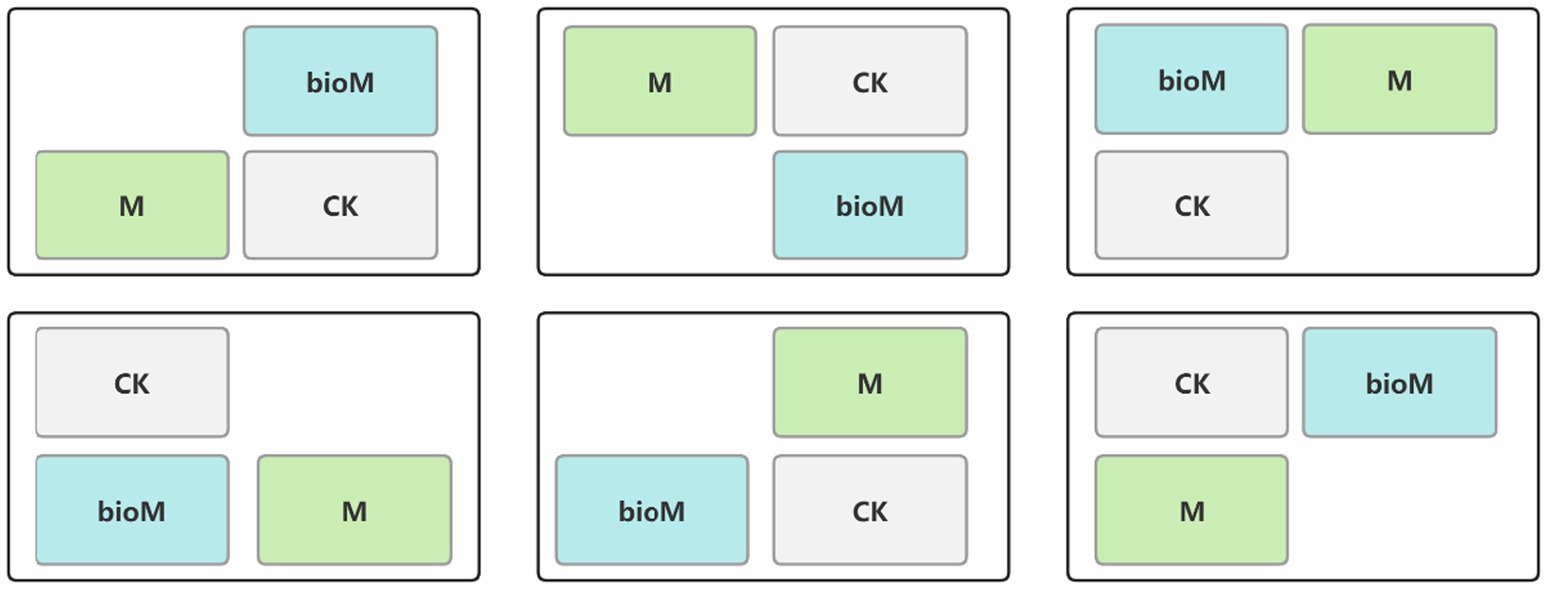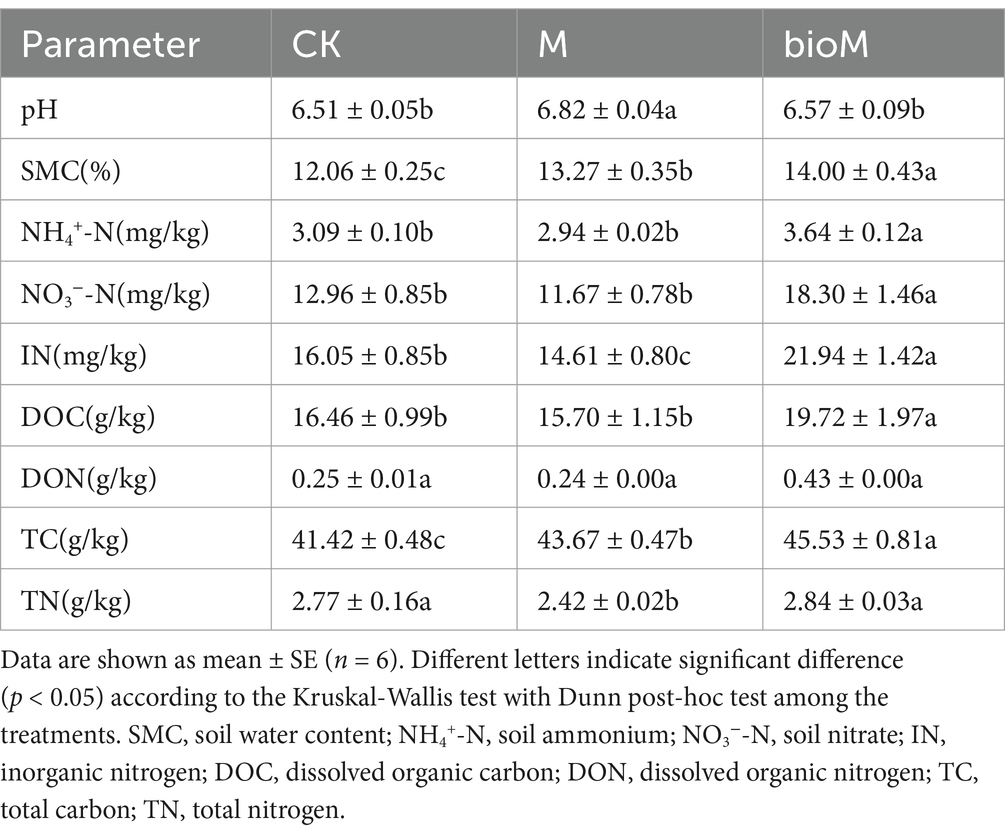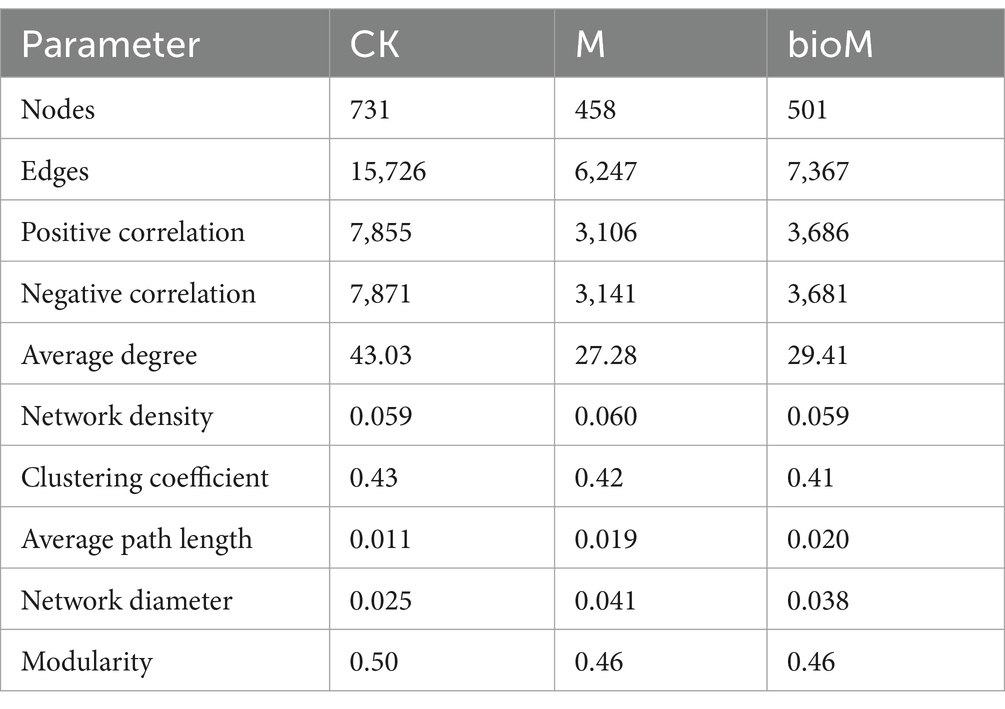- 1Key Laboratory of Land Resources Evaluation and Monitoring in Southwest, Ministry of Education, Sichuan Normal University, Chengdu, China
- 2College of Life Sciences, Sichuan Normal University, Chengdu, China
Introduction: Soil health is critical for sustainable agriculture and food security, however, the accumulation of agricultural mulch film residues in soil raises environmental concerns. The effects of conventional polyethylene (PE) and biodegradable (PBAT and PLA) film residues on soil health, microbial communities, and crop productivity under field conditions have not been adequately investigated.
Methods: This study simulated the accumulation of PE film residues from over 30 years of continuous mulching and evaluated PBAT and PLA film residues under field conditions, examining their effects on soil physicochemical properties, microbial communities and rapeseed performance.
Results: The results revealed that PE residues significantly altered microbial community composition, enhancing the relative abundance of core genera, including Sphingomonas, Acidibacter, and Flavisolibacter, while suppressing other genera, such as Burkholderia-Caballeronia-Paraburkholderia. PE residues also inhibited organic matter decomposition and ureolysis, while limiting nitrate availability and soil fertility, although rapeseed yields remained unaffected. In contrast, biodegradable film residues enhanced soil moisture retention and ammonium content, boosted soil functions such as plastic degradation, nutrient cycling, and chitinolysis, and enriched beneficial genera such as Candidatus Udaeobacter, Acidibacter, and Flavisolibacter, although weakened ureolysis activity. However, both residue types reduced the complexity and stability of the bacterial co-occurrence network, suggesting potential risks to the soil microbial habitats.
Conclusion: These findings demonstrate that conventional film residues had no significant effect on rapeseed productivity, whereas biodegradable films exhibited superior performance in maintaining soil fertility and microbial functions under field conditions. Our study emphasizes the need for long-term monitoring to effectively optimize agricultural plastic film applications.
1 Introduction
Agricultural films, particularly white plastic mulches, play a crucial role in agricultural ecosystems. Film mulching boosts crop yields by regulating soil temperature, promoting germination and seedling growth, conserving moisture and accelerating organic matter decomposition. Furthermore, these films improve fertilizer use efficiency, enhance drought resistance, promote earlier crop maturation and ultimately lead to increased yields (Maraveas, 2020; Nizzetto et al., 2016). However, the widespread use of these films, predominantly manufactured from PE, has led to increased soil accumulation owing to inefficient recycling practices and their inherent resistance to degradation (Di Mola et al., 2021). Mechanical stress, weathering, and UV exposure fragment these films into microplastics, introducing persistent pollutants into agricultural ecosystems (Hayes et al., 2017; Kumar et al., 2020; Zhang K. et al., 2021; Song et al., 2023). Mounting evidence suggests that these residues might compromise the soil health and stability (Kumar et al., 2020; Koskei et al., 2021; Lozano et al., 2021; Wang et al., 2021; Huang F. et al., 2023; Zhou et al., 2023).
The microplastics released from agricultural film residues predominantly include fragments, films and fiber forms (Yuan et al., 2022). The current methods for managing these plastic residues in agricultural soils are both time-consuming and costly (Marí et al., 2019). The chemical stability and hydrophobicity of agricultural films render them resistant to biological and chemical degradation, resulting in the accumulation of macro- and microplastics in agricultural soils (Angelucci and Tomei, 2020). Substantial variations in plastic film residue concentrations across different agricultural regions of China have been documented. For instance, concentrations range from 4.94 pieces per kilogram in the lower Yangtze River region to a remarkably high 40,800 pieces per kilogram in Yunnan (Zhang Q. Q. et al., 2021). Among these residues, polyethylene and polypropylene are the predominant (Tang, 2023). This accumulation negatively affects crop productivity through alterations in soil structure and microbial community composition (Zhao et al., 2021; Li C. et al., 2022), ultimately compromising plant growth (Koskei et al., 2021). Yield reductions have been observed across various crops, including wheat (Qi et al., 2020), maize, cotton, potatoes (Gao et al., 2019; Zhang et al., 2020) and green beans (Jiang et al., 2019). In response to these challenges, biodegradable agricultural films have emerged as potential alternatives to conventional PE films (Piyathilake et al., 2024). These films typically degrade within one year in open fields and five years under greenhouse conditions (Velandia et al., 2020). The rapid release of additives also highlight the need for further research to ensure their safe and sustainable application in agriculture.
Soil microbiome underpins soil and human health by mediating nutrient cycling, pollutant degradation and enhancing plant immunity, fertility and yield (Chen et al., 2020; Dai et al., 2020; Wei et al., 2020; Chepsergon and Moleleki, 2023; Liu Z. et al., 2024). The functional capacity of ecosystems, particularly in nutrient cycling processes, is positively correlated with microbial community diversity and network complexity (Wagg et al., 2019; Ling et al., 2022). Recent studies have highlighted the significant influence of microplastics on rhizosphere bacterial communities, including their diversity and abundance (Sun et al., 2021). Both conventional and biodegradable microplastics influence soil nitrogen availability, enzyme activities and diazotrophic networks, with effects varying by type and concentration (Wang et al., 2023). Additionally, microplastics can enhance the rhizosphere microbial abundance and nitrogen metabolism (Kim et al., 2023). These findings are further supported that microplastics significantly affect plant oxidative stress, photosynthetic efficiency and soil microbial activity (Wang W. et al., 2024). PBAT microplastics induce dynamic shifts in bacterial community composition, influenced by particle size, concentration and soil residence time (Shang et al., 2024). Similarly, PLA treatment distinctly alters the bacterial diversity and composition in rice soils compared to PVC and PET (Sun X. et al., 2022). In a rice pot experiment, plastic film residues of different sizes significantly altered soil properties and rhizosphere microbiota, reducing soil density, increasing porosity, modifying enzyme activity and raising dissolved nitrogen levels (Fu et al., 2023). However, research on how conventional and biodegradable agricultural film residues affects soil properties, rhizosphere bacterial communities and plant productivity under field conditions remain limited.
Rapeseed is the predominant oilseed crop in China’s upper Yangtze River region and represents a crucial source of edible oil and renewable energy. The southwestern region alone contributes 28.4% of national production (Hu et al., 2017; Wang H. et al., 2024). This study investigated the effects of PE film residues accumulated over 30 years of continuous mulching, along with one-year PBAT and PLA film residues under field conditions. Specifically, we examined their effects on rapeseed performance, soil physicochemical properties, and microbial communities. We aimed to answer the following three questions: (1) How do these two types of film residue affect rapeseed performance? (2) Do they change soil characteristics, microbial community dynamics? (3) What is the relationship between changes in soil characteristics, microbial community structures and rapeseed productivity?
2 Materials and methods
2.1 Field design and sample collection
The field experiment was carried out at Qiushi Farm, Chengdu, Sichuan (30°34′N, 104°11′E), as described by Sun et al. (2025). The site is characterized by an annual mean temperature of 14–22°C, average yearly rainfall of 771.8 mm, and a cumulative annual temperature of 4,600–5,000°C. The soil is classified as Alfisols, with a pH ranging from 6.5 to 7.0 and 2–4% organic matter.
A 40 × 50 m plot that had functioned as a seedling nursery for the past decade was selected for the experiment. The study used a split-plot design, establishing six main plots (10 × 8 m each), separated by 5 m to reduce edge effects (Figure 1). Each main plot included three treatments: control (CK, no film), PE film addition (M) and PBAT+PLA biodegradable film addition (bioM). The design was based on data regarding residual soil film fragments from 32 years of agricultural film use (Li S. et al., 2022).
Conventional polyethylene (PE) films were purchased from Chengdu Jiuzhou Fengle Agricultural Technology Co., Ltd., while biodegradable PBAT+PLA films were obtained from Jialemi Horticultural Technology Co., Ltd. Both types had a uniform thickness of 0.01 mm. Application rates for film fragments were determined for the 0–30 cm soil layer. For PE films, 0.0915% (w/w) was used for fragments smaller than 4 cm2 and 0.0183% (w/w) for fragments between 4–25 cm2 (Li S. et al., 2022). For PBAT+PLA films, application rates were based on the actual annual coverage in each plot and prepared fragments accordingly, 83.33 g for pieces smaller than 4 cm2 and 41.67 g for those sized 4–25 cm2. To simulate natural aging process of film fragments, the experiment began in March 2023 before maize planting. Prior to film fragments were applied, all plots were fertilized with potassium nitrate and urea (N:P:K = 280:112.7:180 g) according to Khan et al. (2017), along with subsequent fertilization as needed (Yousaf et al., 2017). Pre-prepared film fragments were then incorporated into the top 30 cm of soil using a rotary tiller. After the maize harvest in July 2023, soils were tilled and dried to further promote film fragment aging.
In November 2023, rapeseed was sown. Plant and soil samples were collected at three critical stages: 30 days post-transplantation (vegetative stage), 60 days (flowering stage) and 90 days (maturity stage). At each sampling point, both aboveground plant tissues and fine roots were collected for laboratory measurements of physiological traits, including plant height and root diameter, using a steel tape and calipers. Soil samples were taken near plants using a five-point composite sampling method at a depth of 0–20 cm, after removing surface debris. Soil adhering to fine roots was combined to create composite samples, 18 samples per sampling time point, for a total of 54 soil samples over three sampling rounds. In the laboratory, soil samples were passed through a 2 mm sieve and divided: one portion was air-dried for physicochemical analysis, while the other was stored at −80°C for further study. Seed yield was determined by weighing rapeseed after the April 2024 harvest.
2.2 Measurement of soil and plant physicochemical parameters
The plant samples were subjected to a two-step drying process: initial blanching at 100°C for 30 min, followed by complete drying at 80°C for moisture content determination. The plant biomass was quantified by direct weighing. For the soil analyses, the moisture content was determined gravimetrically (drying at 105°C), and the pH was measured using a 2.5:1 soil-to-water ratio. The total inorganic nitrogen in the soil was extracted using a 2 M KCl solution. Nitrate nitrogen was quantified using ultraviolet–visible spectrophotometry, whereas ammonium nitrogen was determined using the potassium chloride-indigo blue colorimetric method. Total carbon (TC) was measured using the potassium dichromate method, while total nitrogen (TN) was determined using the Kjeldahl method after digestion with H2SO4. For soluble organic carbon and nitrogen analysis, samples were extracted with 0.5 M K₂SO₄ (1,5 ratio), followed by quantification procedures similar to those used for total carbon and nitrogen determination.
2.3 High-throughput sequencing of bacterial 16S rDNA
Given the consistent physicochemical trends across sampling times, we selected 18 soil samples at the 60-day vigorous growth stage for representative high-throughput sequencing analysis. Genomic DNA was extracted from 0.5–0.7 g soil samples following Liu et al. (2018). DNA quality was verified by 0.7% agarose gel electrophoresis and quantification was performed using a Nanodrop 2000 spectrophotometer. The bacterial 16S rDNA V4 region was amplified using the primers 515F and 806R (Parada et al., 2016). The amplification success was confirmed using 2% agarose gel electrophoresis, followed by sequencing on the Illumina PE250 platform.
2.4 Bioinformatics analysis
Raw sequencing data were processed by paired-end merging using the FLASH program, and barcodes were removed during preprocessing. Quality control of the sequences was performed using the QIIME2. Sequences were filtered based on the following criteria: average base quality score <30, length <200 base pairs, or presence of ambiguous bases (N). The Deblur algorithm within QIIME2 was applied for sequence denoising and chimera removal, resulting in Amplicon Sequence Variant (ASV) tables and representative sequences. Taxonomic classification was performed using a Naïve Bayes classifier trained using the SILVA v138 database. Phylogenetic trees were constructed using FastTree plugin QIIME2. To standardize the sampling effort, all samples were rarefied to a minimum sequencing depth of 34,234 reads. All sequence data were deposited in the National Center for Biotechnology Information Sequence Read Archive under accession number PRJNA1197682.
Alpha diversity metrics, including Shannon and Simpson indices, were calculated using the vegan package in R. Comparisons of diversity between treatments were performed using the Wilcoxon rank-sum test for pairwise comparisons and Kruskal-Wallis test for multiple groups, with post-hoc analyses adjusted using the Agricolae package. Beta diversity was assessed using Bray-Curtis distances, which were calculated using the Vegan package in R. Principal coordinate analysis (PCoA) was performed for visualization using the ape and Vegan packages to create ordination plots. Permutational Multivariate Analysis of Variance (PERMANOVA) was performed using the Adonis function in Vegan. To predict potential microbial metabolic and ecological functions, the FAPROTAX tool was used for functional annotation of ASV tables. Random forest analysis was conducted using the RandomForest package in R to identify the key microbial functional groups associated with film residues.
Microbial co-occurrence networks were constructed to evaluate the soil microbial community dynamics. Robust correlations (Spearman correlation coefficients >0.8 or <−0.8 with adjusted p-values <0.05) were calculated to define edge connections between nodes (Jiao et al., 2022). Network metrics, including the total number of nodes, links, network diameter, average clustering coefficient, and relative modularity, were computed using the igraph package in R (version 4.3.3) (Yuan et al., 2021). Network visualization was performed using the Gephi software. Positive and negative cohesion values were calculated to assess bacterial community complexity (Herren and McMahon, 2017; She et al., 2021). Network visualizations were generated using the Gephi software. The stability of the soil microbial network was assessed using a network robustness analysis. Simulated random species removal was performed by excluding 50% of the network nodes and evaluating changes in connectivity and network metrics. The ratio of absolute negative to positive cohesion was used to calculate network stability (Wu et al., 2023). Structural equation modeling was conducted to explore causal relationships among soil properties, microbial communities, and rapeseed yield using the plspm package in R (version 4.3.3).
3 Results
3.1 Fundamental characteristics of plants and soil
Rapeseed yield and aboveground biomass showed distinct responses to the different treatments (Figures 2a,b). While the M treatment resulted in a slight, non-significant reduction in yield compared to the control (CK), the bioM treatment significantly enhanced both the yield and aboveground biomass (p < 0.05). Although the M treatment showed a trend toward increased biomass, this change was not statistically significant. The soil physicochemical properties were substantially altered by both treatments (Table 1). The M treatment significantly increased soil pH and total carbon compared to CK (p < 0.05), but decreased inorganic nitrogen (IN) and total nitrogen content (p < 0.05). Although not statistically significant, reductions were observed in NH4+-N, NO3−-N, dissolved organic carbon (DOC), and dissolved organic nitrogen (DON). In contrast, the bioM treatment significantly enhanced soil moisture content, NH4+-N, NO3−-N, IN, DOC and total carbon compared with CK (p < 0.05).
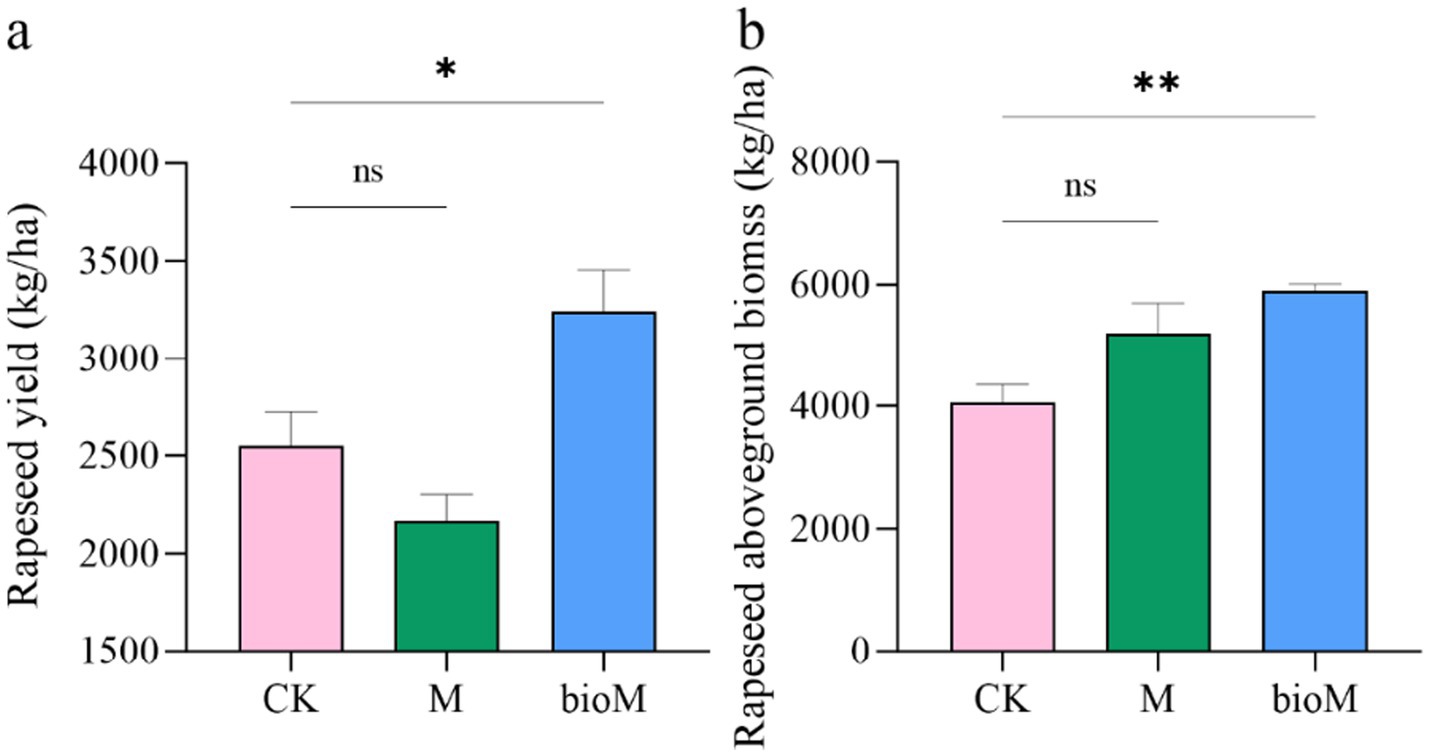
Figure 2. Rapeseed yield (a) and aboveground biomass (b) in the rhizosphere soil with different treatments. Data are shown as mean ± SE (n = 6). An asterisk (*) indicates a significant difference according to the Kruskal-Wallis test with Dunn post-hoc test, with significance levels defined as follows: *p < 0.05, **p < 0.01 and ns indicates no significant difference.
3.2 Diversity and structure of soil bacterial communities
High-throughput sequencing at 100% similarity identified 6,268 bacterial Amplicon Sequence Variants (ASVs), with 1,467, 1,212, and 1729 unique ASVs in CK, M, and bioM treatments, respectively. Among these, 1,038 ASVs were shared across all the treatments (Supplementary Figure S1). Diversity indices (Chao1, Shannon and InvSimpson) consistently showed that the bioM treatment significantly enhanced bacterial diversity compared to CK, while the M treatment reduced diversity (Figures 3a–c). However, both M and bioM treatments significantly reduced Phylogenetic Diversity compared to CK (Figure 3d). Principal coordinate analysis (PCoA) revealed distinct bacterial community compositions among the treatments (Figure 3e). The first two PCoA axes explained 63.3% of the total variance (PC1, 40.4%; PC2, 22.9%). PERMANOVA confirmed significant differences among all treatments: CK vs. M (R2 = 0.50, p = 0.003), CK vs. bioM (R2 = 0.58, p = 0.001) and M vs. bioM (R2 = 0.59, p = 0.002).
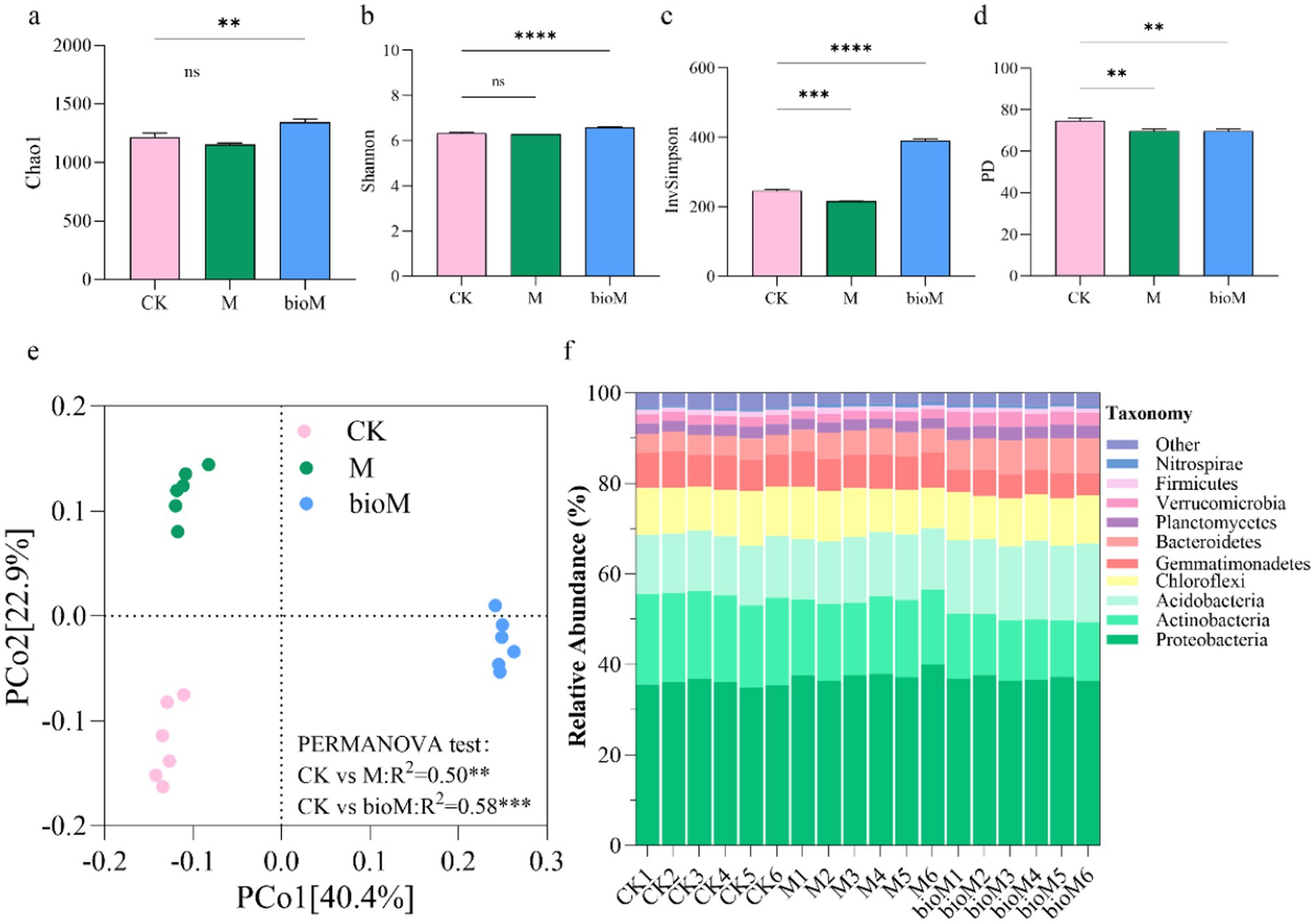
Figure 3. Alpha diversity indices of Chao1 (a), Shannon (b), Simpson (c), PD (d), PCoA analysis based on Bray-Curtis distance (e) and relative abundance of top 10 phyla (f) of bacterial community in rhizosphere soil with different treatments. Data are shown as mean ± SE (n = 6). An asterisk (*) indicates a significant difference according to the Kruskal-Wallis test with Dunn post-hoc test, with significance levels defined as follows: **p < 0.01, ***p < 0.001, ****p < 0.0001 and ns indicates no significant difference.
The top 10 bacterial phyla maintained similar compositions across treatments, although their relative abundances varied considerably (Figure 3f, Supplementary Figure S2). Proteobacteria was dominant across all plots, followed by Actinobacteria, Acidobacteria, Chloroflexi, Gemmatimonadetes, and Bacteroidetes. The M treatment showed increased relative abundances of Proteobacteria, Acidobacteria, Bacteroidetes, and Nitrospirae, but decreased Actinobacteria compared to CK. BioM treatment enhanced the relative abundance of Acidobacteria, Bacteroidetes, Planctomycetes, Verrucomicrobia, and Nitrospirae while reducing the abundance of Actinobacteria and Gemmatimonadetes.
At the genus level, both treatments induced distinct community shifts (Figure 4, Supplementary Figure S3). M significantly increased the relative abundances of Sphingomonas, Acidibacter, Flavisolibacter, Thermomonas, Ramlibacter, Streptomyces, Amycolatopsis and Pedobacter, while reducing Burkholderia-Caballeronia-Paraburkholderia, Massilia, Pseudarthrobacter, HSB OF53-F07, Ellin6067 and Acidothermus. BioM treatment enhanced Candidatus Udaeobacter, Acidibacter, Flavisolibacter and Pedobacter, while decreasing Gemmatimonas, Burkholderia-Caballeronia-Paraburkholderia, Massilia, Pseudarthrobacter, Thermomonas, Acidothermus and Streptomyces compared to CK.
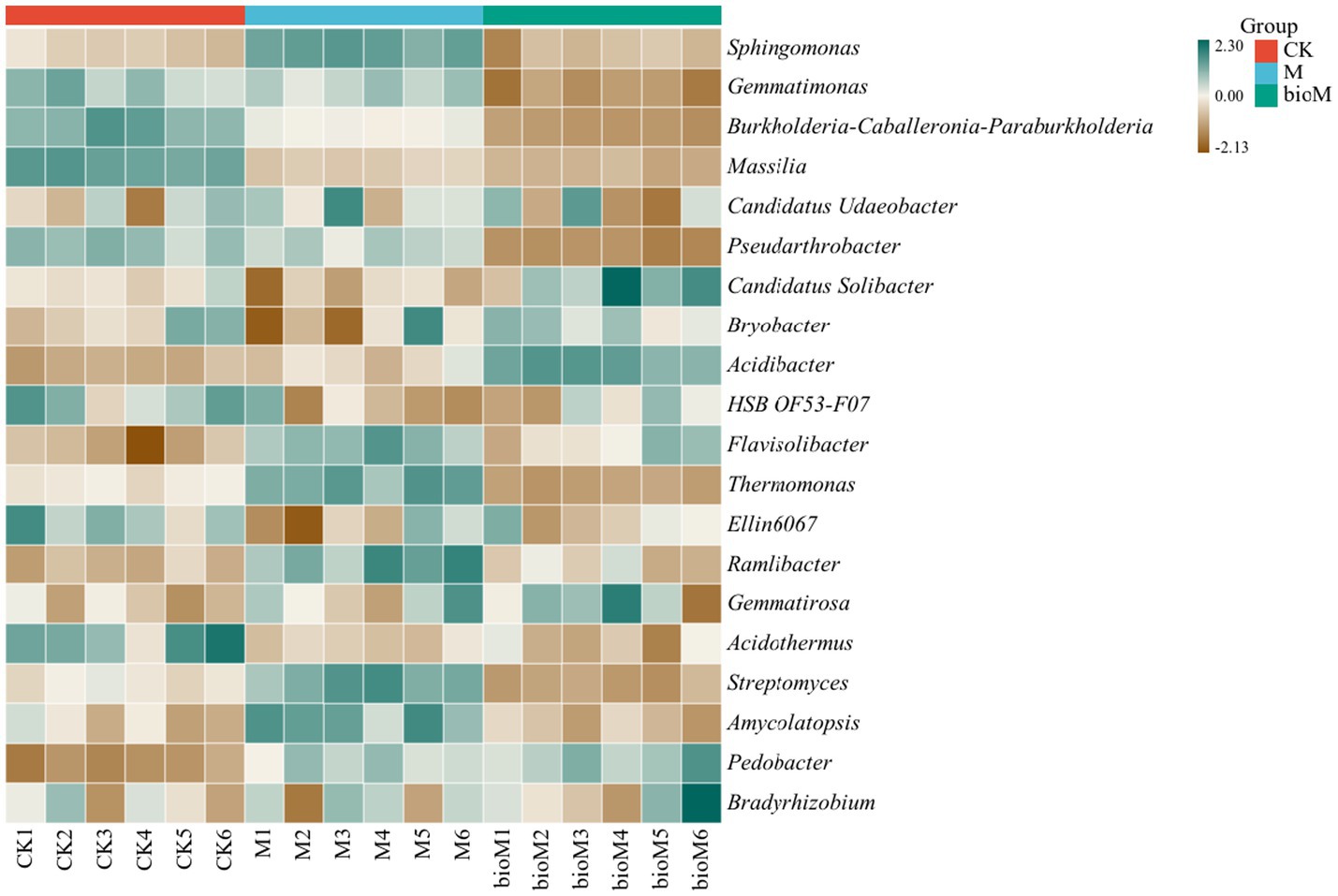
Figure 4. Heatmap of top 30 genera of the bacterial community in rhizosphere soils with different treatments.
3.3 Prediction of soil bacterial community functions
FAPROTAX analysis of 6,268 bacterial ASV sequences identified 92 functional groups, encompassing metabolic processes related to nutrient cycling (nitrogen, carbon, and sulfur), metal transformations (As and Fe), and ecological interactions. Random forest analysis of the 30 key functional groups revealed treatment-specific variations in carbon and nitrogen cycling (Figures 5a,b). In the M treatment, carbon-related functions including oxygenic photoautotrophy, phototrophy, and aerobic chemoheterotrophy showed significant increases compared with CK. However, functions related to aromatic compound degradation, cellulolysis, fermentation, methanogenesis, and chloroplast processes were reduced. Nitrogen-related functions, including aerobic nitrite oxidation, nitrification, nitrate respiration, and chitinolysis, were significantly enhanced, while ureolysis decreased (Figure 5a). The bioM treatment significantly enriched carbon functional groups associated with chitinolysis, plastic degradation, and photosynthetic processes (oxygenic photoautotrophy, phototrophy, and photoautotrophy) compared to CK, while reducing methanogenesis, hydrocarbon degradation, cellulolysis, and aromatic compound degradation. Similarly, nitrogen cycling functions such as aerobic nitrite oxidation, nitrate respiration, and nitrite denitrification were enhanced, although ureolysis decreased (Figure 5b).
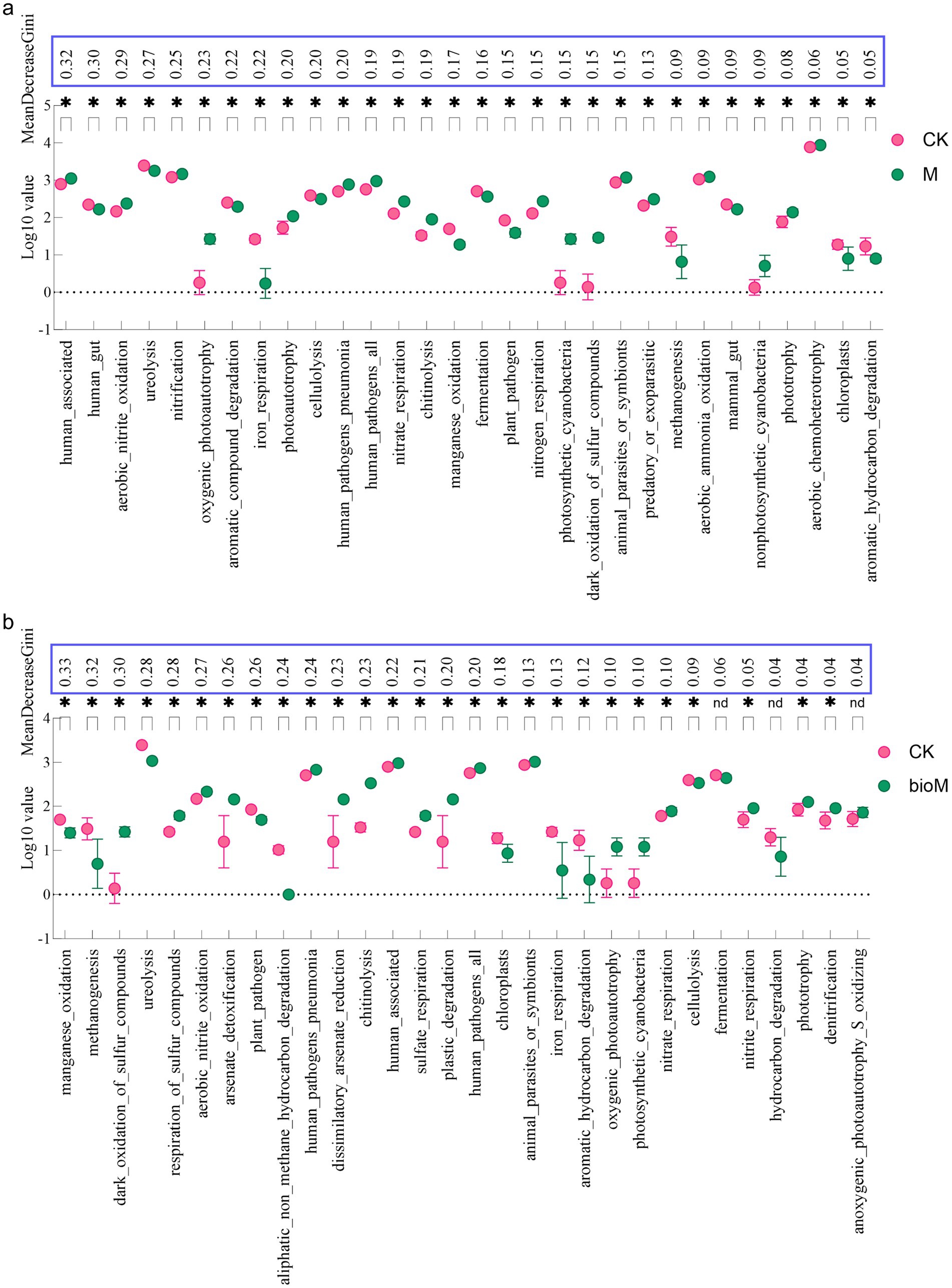
Figure 5. Random Forest analysis of top 30 bacterial functional groups based on FAPROTAX analysis between CK vs. M (a) and CK vs. bioM (b) treatments.
3.4 Co-occurrence network of soil bacterial communities
Network analysis revealed distinct structural changes across the treatments (Figure 6; Table 2). Both M and bioM treatments showed reduced network complexity compared with CK, with lower modularity (M: 0.445, bioM: 0.459, CK: 0.497), average degree (M: 27.28, bioM: 29.41, CK: 43.03)and clustering coefficients (M: 0.417, bioM: 0.409, CK: 0.428). Conversely, the average path lengths (M: 0.019, bioM: 0.020, CK: 0.011) and network diameters (M = 0.041, bioM = 0.038, CK = 0.025) increased significantly. While positive and negative cohesive forces were strengthened in both M and bioM treatments compared to CK (Figures 7a,b), network complexity decreased (Figure 7c). Random node removal analysis demonstrated reduced network robustness for both treatments (Figures 7d,e). The M treatment showed the highest bacterial network vulnerability, while bioM and CK maintained similar vulnerability indices (Figure 7f).
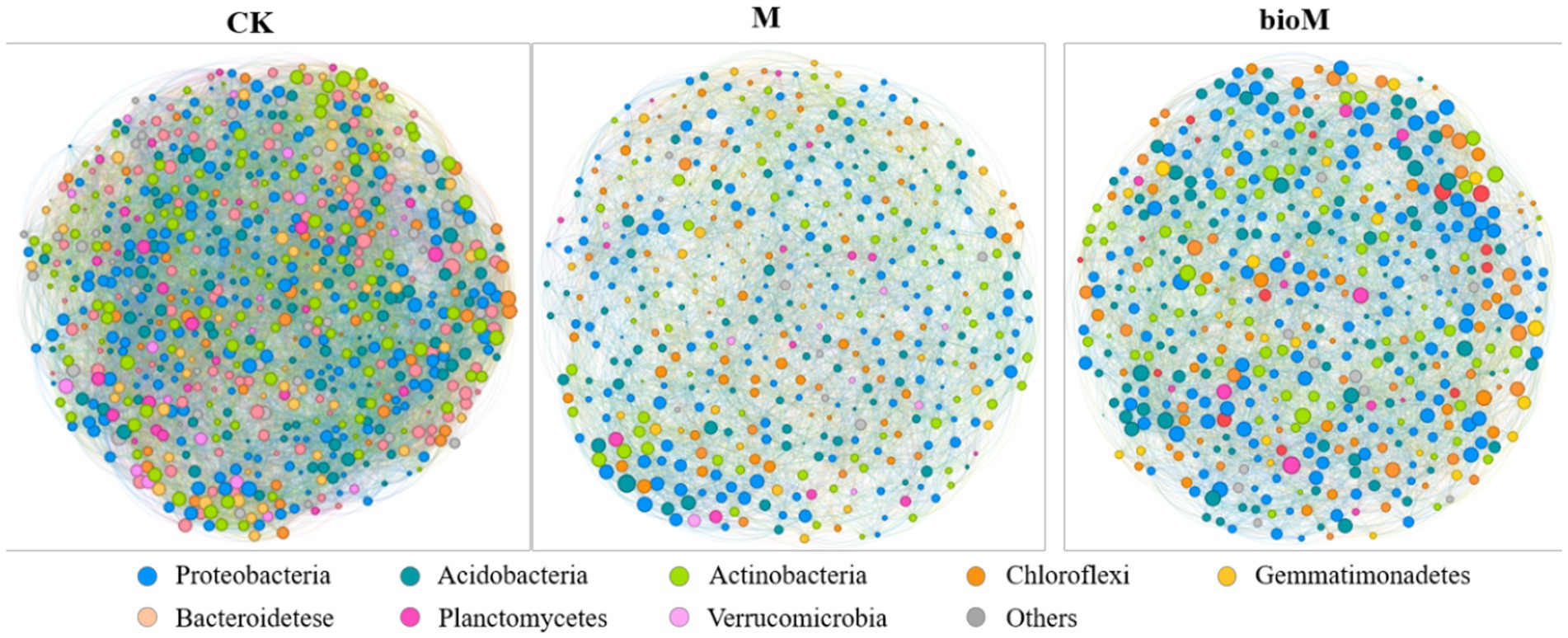
Figure 6. The co-occurrence networks of soil bacterial communities at the ASV level in rhizosphere soil with different treatments.
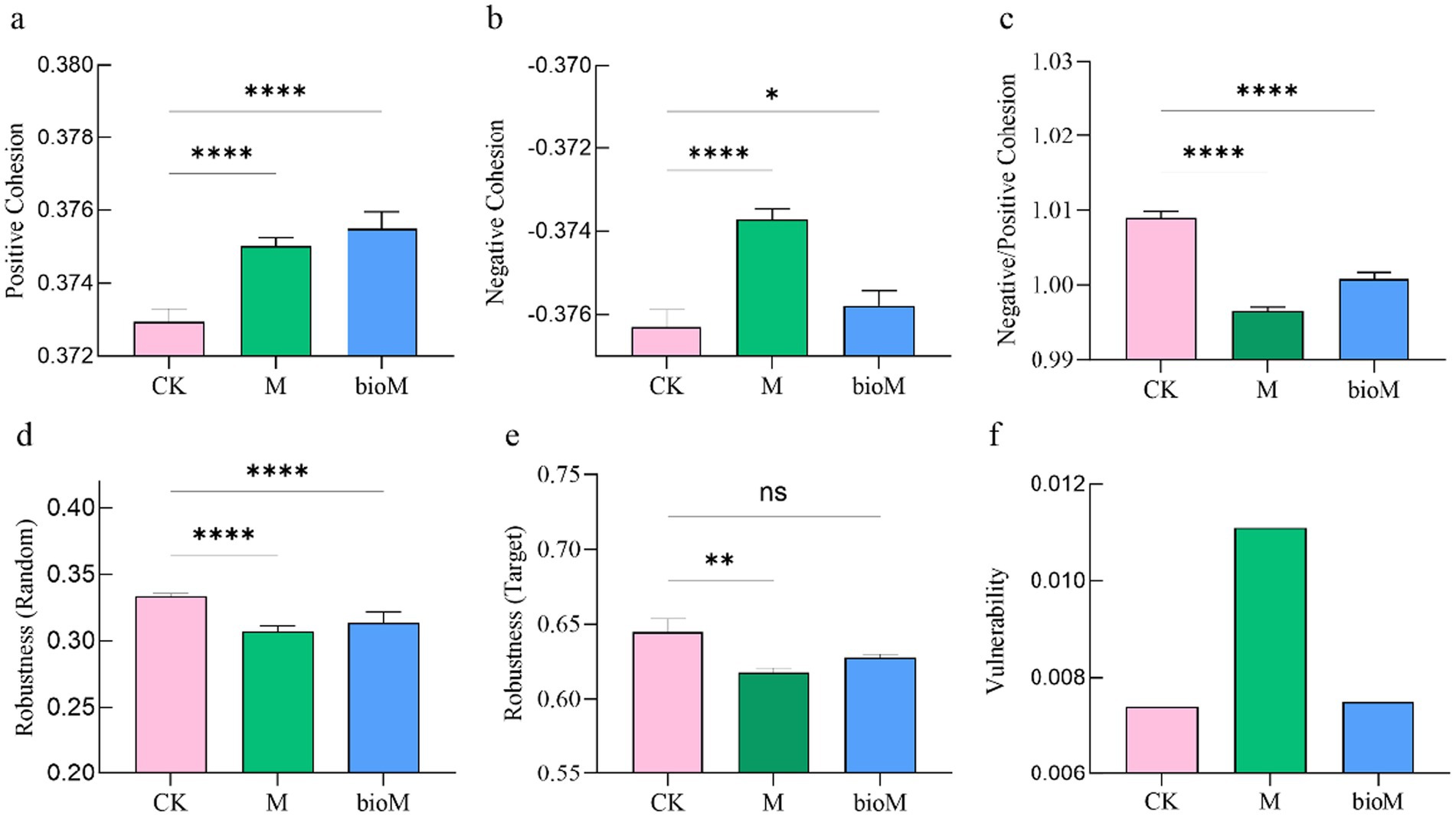
Figure 7. Microbial network stability indices, including positive cohesion (a), negative cohesion (b), network complexity (c) robustness after random removal of samples (d), robustness after targeted removal of specific samples (e) and vulnerability (f) in the rhizosphere soil with different treatments. Data are shown as mean ± SE (n = 6). An asterisk (*) indicates a significant difference according to the Kruskal-Wallis test with Dunn post-hoc test, with significance levels defined as follows: *p < 0.05, **p < 0.01, ****p < 0.0001 and ns indicates no significant difference.
3.5 PLS-PM model of bacterial communities
The partial least squares path model (PLS-PM) revealed distinct treatment effects on soil–plant-microbe interactions (Figure 8). The M treatment model (goodness of fit: 0.71) showed strong positive effects on bacterial communities, functions, and network stability (r = 0.99), but negatively affected soil properties, particularly nitrogen content (r = −0.74), with no direct effect on rapeseed biomass or yield (Figure 8a). The bioM treatment model (goodness of fit: 0.80) demonstrated more comprehensive positive effects, enhancing bacterial communities, functions, and network stability (r = 0.97), which directly improved the rapeseed biomass and yield (r = 0.91). Additionally, bioM treatment positively influenced soil properties (r = 0.90), creating an indirect positive feedback loop through bacterial communities (r = 0.88), which further enhanced plant performance (r = 0.71) (Figure 8b).
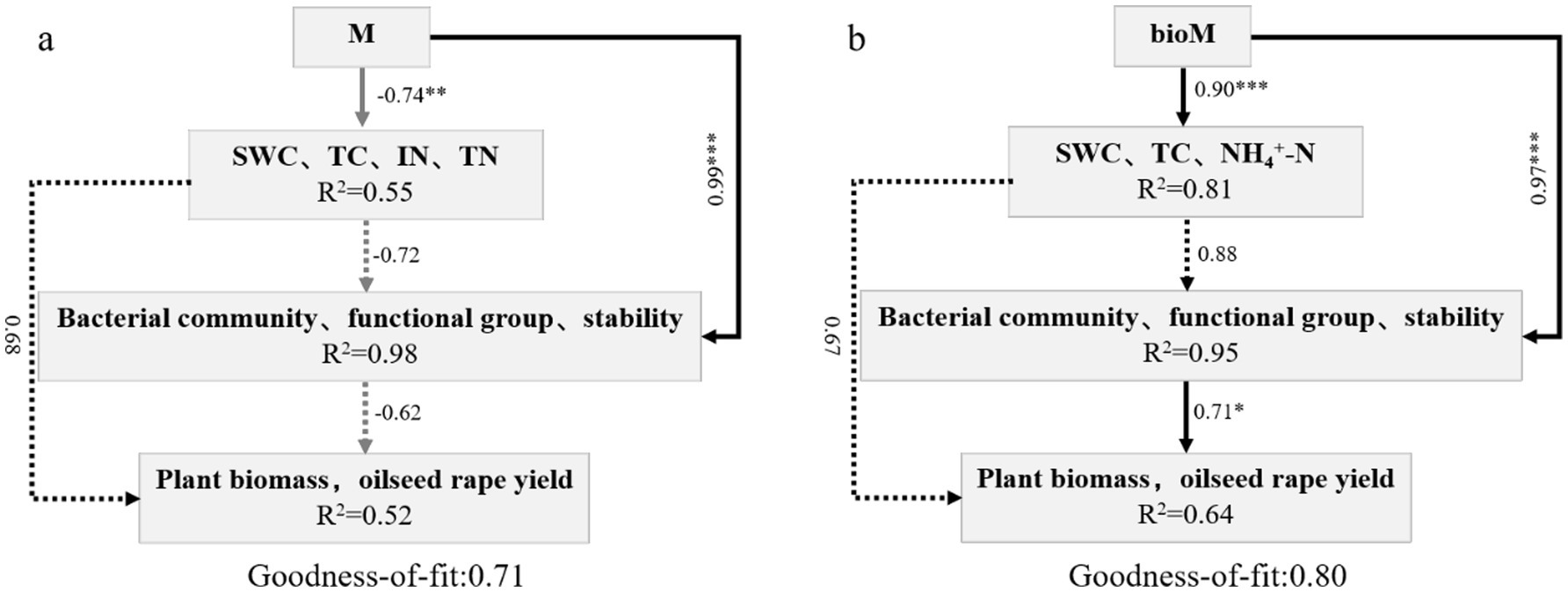
Figure 8. PLS-PM analysis the effects of soil abiotic factors, soil bacterial community, functional group and network stability on rapeseed growth in M (a) and bioM (b) treatments. The path coefficients are indicated by the numbers adjacent to the arrows. Solid arrows represent significant path coefficients (p < 0.05), while dashed arrows indicate non-significant coefficients (p > 0.05). Positive and negative influences are represented in black and gray, respectively.
4 Discussion
In this study, the effects of conventional PE and biodegradable PBAT-PLA film residues on bacterial communities, soil properties and rapeseed performance were comprehensively analyzed. All experimental questions were confirmed. Conventional PE residues had no significant impact on rapeseed biomass or yield but decreased soil inorganic nitrogen, bacterial α-diversity, and organic matter degradation functions, significantly weakening microbial network stability. In contrast, biodegradable residues enhanced rapeseed productivity by improving soil fertility and microbial diversity and enriching functional groups involved in carbon and nitrogen cycling, although they also moderately reduced microbial network stability.
4.1 Impact of agricultural film residues on plant performance and soil physicochemical properties
Our study compared the ecological impacts of conventional polyethylene (PE) and biodegradable PBAT-PLA mulch films, revealing distinct effects on plant growth and soil properties (Figure 2; Table 1). Recent studies have highlighted the significant effects of agricultural film residues on plant growth and soil microbial communities (Qi et al., 2022; Zhou et al., 2023; Shirin et al., 2024; Yang et al., 2024). While previous research has documented the negative effects of film residues on various crops including wheat, maize, potato and cotton (Gao et al., 2019; Qi et al., 2020; Zhang et al., 2020), our findings showed treatment-specific responses.
PE film residues had minimal impact on rapeseed biomass and yield, consistent with observations that PE microplastics negligibly affected maize growth (Ding et al., 2023). In contrast, PBAT-PLA residues significantly enhanced both parameters, aligning with reports of increased peanut yields under biodegradable mulch films (Zhao et al., 2023). One key reason for the difference between our results and those of previous studies is the concentration of film residues applied (Qi et al., 2018). Our experiment applied much lower residue levels, about 0.1% w/w for PE and similarly low rates for PBAT-PLA. In contrast, Qi et al. (2018) used a much higher concentration of 1%. Their study found negative effects at this level, no matter the fragment size. This highlights a strong dose-dependent effect. For example, Zhang et al. (2020) reported that with every 100 kg ha−1 increase in residual mulch film, maize plant height decreased by 2.5%. Therefore, the lower and more realistic concentrations used in our study may explain why we did not observe the same adverse effects as those reported with higher doses.
The observed changes in plant performance were correlated with alterations in soil physicochemical properties, which are crucial determinants of bacterial function (Wu et al., 2022). Both film types significantly increased the total soil carbon content, consistent with previous studies showing enhanced soil organic matter and carbon content following microplastic addition (Kim et al., 2021). For instance, high concentrations (28%) of polypropylene microplastics have been shown to increase soil soluble organic carbon by over 35% (Liu et al., 2017). This suggests that plastic mulch residues contribute to soil carbon content independently of photosynthetic processes and net primary production (Rillig and Lehmann, 2020), although distinguishing between soil and plastic-derived carbon remains technically challenging.
The treatments had contrasting effects on soil nitrogen dynamics. PBAT-PLA films significantly increased inorganic nitrogen (ammonium and nitrate) and soluble organic nitrogen concentrations, while PE films reduced inorganic nitrogen levels. These findings align with previous research showing that non-degradable plastics (0.3–1%) reduce nitrate and ammonium nitrogen in rice paddy soils (Sun X. et al., 2022). Such changes in nitrogen availability directly influence crop performance, as demonstrated by studies showing reduced maize growth and nitrogen uptake in soils containing 0.5% PET microplastics (Ingraffia et al., 2022; Hu et al., 2020). The differential effects of plastic type on soil nitrogen cycling processes are well documented (Seeley et al., 2020), which enhances nitrification and denitrification, while polyvinyl chloride inhibits these processes. Our results support these findings, demonstrating that biodegradable films improve soil nutrient status and consequently enhance rapeseed yield.
4.2 Influence of agricultural film residues on soil bacterial community diversity and composition
Agricultural film residues significantly influenced soil bacterial α-diversity, depending on the treatment (Figure 3). BioM treatment enhanced bacterial α-diversity compared to the controls, which is consistent with previous observations of increased microbial diversity under biodegradable film treatments (Lian et al., 2022). Conversely, conventional PE films (M treatment) reduced bacterial α-diversity, aligning with studies showing decreased bacterial abundance and diversity following the addition of 1% LDPE addition (Fei et al., 2020). This divergent effect on bacterial diversity likely stems from differences in carbon bioavailability between film types. Biodegradable plastics hydrolyze into water-soluble, low-molecular-weight oligomers that serve as readily available carbon sources for microorganisms (Sun Y. et al., 2022). The increased soil organic nitrogen and carbon levels observed in bioM treated soils were positively correlated with enhanced microbial diversity (Li C. et al., 2022), suggesting that improved nutrient availability supports more diverse bacterial communities.
Both treatments significantly altered the composition of the dominant bacterial taxa, reflecting the strong relationship between soil nutrient status and bacterial diversity (Wagg et al., 2021). The predominant phyla identified were Proteobacteria, Actinobacteria, Acidobacteria, Chloroflexi, Gemmatimonadetes, and Bacteroidetes, which is consistent with communities found in organically enriched and microplastic-contaminated soils (Li C. et al., 2022). The M treatment enhanced the abundance of Proteobacteria, Acidobacteria, Bacteroidetes, and Nitrospirae abundance while reducing Actinobacteria. The bioM treatment increased Acidobacteria, Bacteroidetes, Planctomycetes, Verrucomicrobia and Nitrospirae, but decreased Actinobacteria and Gemmatimonadetes (Figure 3, Supplementary Figure S2). These shifts reflect the functional roles of specific taxa. Proteobacteria, among the most metabolically versatile phyla, contribute to various physiological processes and nutrient cycling, including the degradation of biodegradable PBAT and PLA films (Han et al., 2021). Acidobacteria serves as an indicator of soil nutrient status (Acuña et al., 2020), while Bacteroidetes thrives in nutrient-rich environments, facilitating nutrient cycling (Griffith et al., 2017). Actinobacteria, which are crucial for rhizosphere processes, support nutrient cycling and promote plant growth (Merzaeva and Shirokikh, 2006).
At the genus level (Figure 4, Supplementary Figure S3), conventional film residues enhanced populations of hydrocarbon-degrading bacteria such as Sphingomonas, Streptomyces, and Amycolatopsis, which promote soil health through nutrient cycling and organic matter decomposition (Chigwada and Tekere, 2023; Shen et al., 2023; Zhou et al., 2024). Sphingomonas specializes in complex organic compound metabolism and pollutant degradation (Aulestia et al., 2021). The observed decrease in Burkholderia-Caballeronia-Paraburkholderia, Massilia and Acidothermus likely reflects habitat disruption by film residues, potentially affecting their roles in nitrogen assimilation and plant-microbe interactions (Liu R. et al., 2024; Zhang et al., 2024). In contrast, biodegradable film residues enriched Candidatus Udaeobacter, Acidibacter, Flavisolibacter and Pedobacter genera, suggesting enhanced organic carbon and nutrient availability. These genera play crucial roles in organic matter degradation and nutrient mobilization and support plant growth and soil fertility (Brabcova et al., 2016; Li C. et al., 2022).
4.3 Impact of agricultural film residues on predicted functional profiles of soil bacterial communities
FAPROTAX analysis revealed treatment-specific effects on bacterial functional profiles (Figures 5a,b), with primary functions centered on nitrogen and carbon cycling, consistent with recent studies (Liu et al., 2023). Soil microbial communities are crucial mediators of nutrient cycling, particularly for nitrogen and carbon transformations (Liang et al., 2020). In the M treatment, carbon-related functional genes showed divergent responses. While genes associated with oxygenic photosynthesis and phototrophic processes increased significantly, those involved in aromatic hydrocarbon and cellulose degradation decreased compared to controls. This suggests that conventional PE film residues may impede organic carbon transformation and energy release from organic matter, potentially compromising soil ecological function and agricultural productivity (Qian et al., 2018). The inert nature and slow turnover of conventional film residues likely restrict organic carbon availability for microbial utilization. The nitrogen cycling genes in the M treatment exhibited complex dynamics. Despite enrichment in groups related to aerobic nitrous oxide oxidation, nitrification and nitrogen respiration, urease-related functions decreased significantly. This imbalance may impair nitrogen mineralization and plant nitrogen uptake, which is consistent with previous observations that microplastic addition (1% LDPE, 30-day exposure) reduces nitrate reduction functionality (Chen et al., 2022).
The bioM treatment demonstrated distinct functional patterns, with significant enrichment of groups related to chitin degradation, plastic degradation and photoautotrophy, while showing reduced abundance of non-methane aliphatic and aromatic hydrocarbon degradation groups. These changes suggest optimized organic carbon transformation and resource utilization, potentially contributing to improved agricultural yields (Huang J. et al., 2023). Nitrogen cycling groups in the bioM treatment showed a broad enhancement, despite the reduced urease-related group abundance. This pattern indicates that biodegradable film residues may provide nutrient-rich substrates that support increased microbial biomass and enhanced nitrogen cycling capacity (Zhang et al., 2024). Such improvements in microbial performance can enhance nitrogen fixation and plant nutrient uptake, ultimately promoting plant growth and crop yields (Tang et al., 2020).
The influence of agricultural film residues, particularly biodegradable variants, extends beyond the immediate nutrient cycling. These materials can reshape microbial community structure and function by providing energy and nutrients that support microbial proliferation and enzyme activity (Sun Y. et al., 2022). However, the observed enrichment of human pathogens and animal parasites in both treatments warrant careful consideration. Although FAPROTAX provides valuable insights, further research is needed to validate these functional predictions and their implications for agricultural systems.
4.4 Impact of agricultural film residues on co-occurrence network stability of soil bacterial communities
Both conventional and biodegradable film residues significantly altered soil bacterial co-occurrence networks, reducing their complexity and stability (Figures 6, 7). The observed decrease in network nodes and connections indicates diminished interconnectedness within the microbial communities. Cohesion parameter analysis, which characterizes the strength of positive and negative bacterial relationships and overall community stability (Yuan et al., 2021), revealed that both film types, particularly conventional films, reduce bacterial community complexity and potential species interactions. Network modularity, an indicator of distinct functional habitats within microbial communities (Hernandez et al., 2021), decreased by 10 and 8% in the conventional and biodegradable film treatments, respectively. This reduction suggests the loss of functional niches in response to agricultural film residues (Yuan et al., 2021; Shi et al., 2022), potentially compromising ecosystem functionality. The observed decrease in network stability indicates reduced resistance to external perturbations, which typically correlates positively with the network complexity (Cornell et al., 2023; Artime et al., 2024). This diminished modularity further suggests limited ecosystem resilience, consistent with previous studies showing that residual agricultural films disrupt co-occurrence networks and alter microbial diversity (Wu et al., 2022). The decreased network robustness, particularly pronounced in conventional film treatments, indicates increased vulnerability of microbial communities to environmental stressors.
While both film types affected network stability, biodegradable films appeared to have less severe effects. Their potential to serve as labile carbon sources may promote microbial metabolic activity and enhance interactions related to resource utilization and niche differentiation compared with conventional films (Huang F. et al., 2023). However, the long-term implications of biodegradable film residues, particularly their accumulation and impact on soil ecosystem stability, require further investigation (Zhu et al., 2022; Rillig et al., 2024).
5 Conclusion
This study compared the effects of conventional PE film residues and biodegradable PBAT-PLA residues on plant performance, soil properties and microbial communities under field conditions. Conventional PE film residues had minimal impact on rapeseed biomass and yield, but significantly reduced inorganic and total nitrogen contents, thereby impairing soil fertility. They also decreased the abundance of Actinobacteria, potentially hindering organic matter degradation by suppressing key functions such as aromatic hydrocarbon and cellulose decomposition. Furthermore, PE residues substantially weaken microbial network stability and increase the ecosystem vulnerability to external stressors. In addition, biodegradable PBAT-PLA film residues significantly enhanced rapeseed biomass and yield by improving soil fertility and microbial diversity. These residues enriched the functional groups associated with carbon and nitrogen cycling, such as those involved in chitin and plastic degradation, nitrogen respiration, optimizing nutrient cycling and resource utilization. While biodegradable residues also reduced microbial network stability, their effects were less disruptive than those of PE residues. In summary, although biodegradable films offer short-term benefits for crop productivity and soil fertility, both conventional and biodegradable residues negatively impact soil microbial community structure and stability. These findings highlight the need to consider the long-term ecological effects of all types of film residues when promoting agricultural plastic alternatives.
Data availability statement
The datasets presented in this study can be found in online repositories. The names of the repository/repositories and accession number(s) can be found in the article/Supplementary material.
Author contributions
MX: Formal analysis, Investigation, Methodology, Writing – original draft. MW: Data curation, Formal analysis, Investigation, Methodology, Writing – original draft. QS: Investigation, Methodology, Writing – original draft. GW: Investigation, Methodology, Writing – original draft. TS: Investigation, Methodology, Writing – original draft. XH: Investigation, Methodology, Project administration, Writing – original draft. DL: Conceptualization, Funding acquisition, Supervision, Writing – review & editing.
Funding
The author(s) declare that financial support was received for the research and/or publication of this article. This research was funded by the National Natural Science Foundation of China, grant number 31800425 and the APC was funded by Talent Program by Sichuan Normal University, grant number pt31800425.
Conflict of interest
The authors declare that the research was conducted in the absence of any commercial or financial relationships that could be construed as a potential conflict of interest.
Generative AI statement
The authors declare that no Gen AI was used in the creation of this manuscript.
Publisher’s note
All claims expressed in this article are solely those of the authors and do not necessarily represent those of their affiliated organizations, or those of the publisher, the editors and the reviewers. Any product that may be evaluated in this article, or claim that may be made by its manufacturer, is not guaranteed or endorsed by the publisher.
Supplementary material
The Supplementary material for this article can befound online at: https://www.frontiersin.org/articles/10.3389/fmicb.2025.1553807/full#supplementary-material
References
Acuña, J. J., Marileo, L. G., Araya, M. A., Rilling, J. I., Larama, G. A., Mora, M. L., et al. (2020). In situ cultivation approach to increase the Culturable bacterial diversity in the Rhizobiome of plants. J. Soil Sci. Plant Nutr. 20, 1411–1426. doi: 10.1007/s42729-020-00222-0
Angelucci, D. M., and Tomei, M. C. (2020). Uptake/release of organic contaminants by microplastics: a critical review of influencing factors, mechanistic modeling, and thermodynamic prediction methods. Crit. Rev. Environ. Sci. Technol. 52, 1356–1400. doi: 10.1080/10643389.2020.1856594
Artime, O., Grassia, M., De Domenico, M., Gleeson, J. P., Makse, H. A., Mangioni, G., et al. (2024). Robustness and resilience of complex networks. Nat. Rev. Phys. 6, 114–131. doi: 10.1038/s42254-023-00676-y
Aulestia, M., Flores, A., Mangas, E. L., Pérez-Pulido, A. J., Santero, E., and Camacho, E. M. (2021). Isolation and genomic characterization of the ibuprofen-degrading bacterium Sphingomonas strain MPO218. Environ. Microbiol. 23, 267–280. doi: 10.1111/1462-2920.15309
Brabcova, V., Novakova, M., Davidova, A., and Baldrian, P. (2016). Dead fungal mycelium in forest soil represents a decomposition hotspot and a habitat for a specific microbial community. New Phytol. 210, 1369–1381. doi: 10.1111/nph.13849
Chen, S.-C., Sun, G.-X., Yan, Y., Konstantinidis, K. T., Zhang, S.-Y., Deng, Y., et al. (2020). The great oxidation event expanded the genetic repertoire of arsenic metabolism and cycling. Proc. Natl. Acad. Sci. USA 117, 10414–10421. doi: 10.1073/pnas.2001063117
Chen, Y., Wang, X., Wang, X., Cheng, T., Fu, K., Qin, Z., et al. (2022). Biofilm structural and functional features on microplastic surfaces in greenhouse agricultural soil. Sustain. For. 14:7024. doi: 10.3390/su14127024
Chepsergon, J., and Moleleki, L. N. (2023). Rhizosphere bacterial interactions and impact on plant health. Curr. Opin. Microbiol. 73:102297. doi: 10.1016/j.mib.2023.102297
Chigwada, A. D., and Tekere, M. (2023). The plastic and microplastic waste menace and bacterial biodegradation for sustainable environmental clean-up a review. Environ. Res. 231:116110. doi: 10.1016/j.envres.2023.116110
Cornell, C. R., Zhang, Y., Ning, D., Xiao, N., Wagle, P., Xiao, X., et al. (2023). Land use conversion increases network complexity and stability of soil microbial communities in a temperate grassland. ISME J. 17, 2210–2220. doi: 10.1038/s41396-023-01521-x
Dai, Z., Liu, G., Chen, H., Chen, C., Wang, J., Ai, S., et al. (2020). Long-term nutrient inputs shift soil microbial functional profiles of phosphorus cycling in diverse agroecosystems. ISME J. 14, 757–770. doi: 10.1038/s41396-019-0567-9
Di Mola, I., Ventorino, V., Cozzolino, E., Ottaiano, L., Romano, I., Duri, L. G., et al. (2021). Biodegradable mulching vs traditional polyethylene film for sustainable solarization: chemical properties and microbial community response to soil management. Appl. Soil Ecol. 163:103921. doi: 10.1016/j.apsoil.2021.103921
Ding, F., Li, S., Lu, J., Penn, C. J., Wang, Q.-W., Lin, G., et al. (2023). Consequences of 33 years of plastic film mulching and nitrogen fertilization on maize growth and soil quality. Environ. Sci. Technol. 57, 9174–9183. doi: 10.1021/acs.est.2c08878
Fei, Y., Huang, S., Zhang, H., Tong, Y., Wen, D., Xia, X., et al. (2020). Response of soil enzyme activities and bacterial communities to the accumulation of microplastics in an acid cropped soil. Sci. Total Environ. 707:135634. doi: 10.1016/j.scitotenv.2019.135634
Fu, F., Long, B., Huang, Q., Li, J., Zhou, W., and Yang, C. (2023). Integrated effects of residual plastic films on soil-rhizosphere microbe-plant ecosystem. J. Hazard. Mater. 445:130420. doi: 10.1016/j.jhazmat.2022.130420
Gao, H., Yan, C., Liu, Q., Ding, W., Chen, B., and Li, Z. (2019). Effects of plasticmulching and plastic residue on agricultural production: a meta-analysis. Sci. Total Environ. 651, 484–492. doi: 10.1016/j.scitotenv.2018.09.105
Griffith, J. C., Lee, W. G., Orlovich, D. A., and Summerfield, T. C. (2017). Contrasting bacterial communities in two indigenous Chionochloa (Poaceae) grassland soils in New Zealand. PLoS One 12:e0179652. doi: 10.1371/journal.pone.0179652
Han, Y., Teng, Y., Wang, X., Ren, W., Wang, X., Luo, Y., et al. (2021). Soil type driven change in microbial community affects poly(butylene adipate-co-terephthalate) degradation potential. Environ. Sci. Technol. 55, 4648–4657. doi: 10.1021/acs.est.0c04850
Hayes, D. G., Wadsworth, L. C., Sintim, H. Y., Flury, M., English, M., Schaeffer, S., et al. (2017). Effect of diverse weathering conditions on the physicochemical properties of biodegradable plastic mulches. Polym. Test. 62, 454–467. doi: 10.1016/j.polymertesting.2017.07.027
Hernandez, D. J., David, A. S., Menges, E. S., Searcy, C. A., and Afkhami, M. E. (2021). Environmental stress destabilizes microbial networks. ISME J. 15, 1722–1734. doi: 10.1038/s41396-020-00882-x
Herren, C. M., and McMahon, K. D. (2017). Cohesion: a method for quantifying the connectivity of microbial communities. ISME J. 11, 2426–2438. doi: 10.1038/ismej.2017.91
Hu, Q., Hua, W., Yin, Y., Zhang, X., Liu, L., Shi, J., et al. (2017). Rapeseed research and production in China. The Crop Journal 5, 127–135. doi: 10.1016/j.cj.2016.06.005
Hu, Q., Li, X., Gonçalves, J. M., Shi, H., Tian, T., and Chen, N. (2020). Effects of residual plastic-film mulch on field corn growth and productivity. Sci. Total Environ. 729:138901. doi: 10.1016/j.scitotenv.2020.138901
Huang, J., Liu, X., Liu, J., Zhang, Z., Zhang, W., Qi, Y., et al. (2023). Changes of soil bacterial community, network structure, and carbon, nitrogen and sulfur functional genes under different land use types. Catena 231:107385. doi: 10.1016/j.catena.2023.107385
Huang, F., Zhang, Q., Wang, L., Zhang, C., and Zhang, Y. (2023). Are biodegradable mulch films a sustainable solution to microplastic mulch film pollution? A biogeochemical perspective. J. Hazard. Mater. 459:132024. doi: 10.1016/j.jhazmat.2023.132024
Ingraffia, R., Amato, G., Iovino, M., Rillig, M. C., Giambalvo, D., and Frenda, A. S. (2022). Polyester microplastic fibers in soil increase nitrogen loss via leaching and decrease plant biomass production and N uptake. Environ. Res. Lett. 17:054012. doi: 10.1088/1748-9326/ac652d
Jiang, X., Chen, H., Liao, Y., Ye, Z., Li, M., and Klobučar, G. (2019). Ecotoxicity and genotoxicity of polystyrene microplastics on higher plant Vicia faba. Environ. Pollut. 250, 831–838. doi: 10.1016/j.envpol.2019.04.055
Jiao, S., Qi, J., Jin, C., Liu, Y., Wang, Y., Pan, H., et al. (2022). Core phylotypes enhance the resistance of soil microbiome to environmental changes to maintain multifunctionality in agricultural ecosystems. Glob. Chang. Biol. 28, 6653–6664. doi: 10.1111/gcb.16387
Khan, S., Anwar, S., Kuai, J., Ullah, S., Fahad, S., and Zhou, G. (2017). Optimization of nitrogen rate and planting density for improving yield, nitrogen use efficiency, and lodging resistance in oilseed rape. Front. Plant Sci. 8:532. doi: 10.3389/fpls.2017.00532
Kim, S. W., Jeong, S.-W., and An, Y.-J. (2021). Microplastics disrupt accurate soil organic carbon measurement based on chemical oxidation method. Chemosphere 276:130178. doi: 10.1016/j.chemosphere.2021.130178
Kim, K., Song, I.-G., Yoon, H., and Park, J.-W. (2023). Sub-micron microplastics affect nitrogen cycling by altering microbial abundance and activities in a soil-legume system. J. Hazard. Mater. 460:132504. doi: 10.1016/j.jhazmat.2023.132504
Koskei, K., Munyasya, A. N., Wang, Y.-B., Zhao, Z.-Y., Zhou, R., Indoshi, S. N., et al. (2021). Effects of increased plastic film residues on soil properties and crop productivity in agro-ecosystem. J. Hazard. Mater. 414:125521. doi: 10.1016/j.jhazmat.2021.125521
Kumar, M., Xiong, X., He, M., Tsang, D. C. W., Gupta, J., Khan, E., et al. (2020). Microplastics as pollutants in agricultural soils. Environ. Pollut. 265:114980. doi: 10.1016/j.envpol.2020.114980
Li, C., Cui, Q., Li, Y., Zhang, K., Lu, X., and Zhang, Y. (2022). Effect of LDPE and biodegradable PBAT primary microplastics on bacterial community after four months of soil incubation. J. Hazard. Mater. 429:128353. doi: 10.1016/j.jhazmat.2022.128353
Li, S., Ding, F., Flury, M., Wang, Z., Xu, L., Li, S., et al. (2022). Macro- and microplastic accumulation in soil after 32 years of plastic film mulching. Environ. Pollut. 300:118945. doi: 10.1016/j.envpol.2022.118945
Lian, Y., Liu, W., Shi, R., Zeb, A., Wang, Q., Li, J., et al. (2022). Effects of polyethylene and Polylactic acid microplastics on plant growth and bacterial Community in the Soil. J. Hazard. Mater. 435:129057. doi: 10.1016/j.jhazmat.2022.129057
Liang, S., Deng, J., Jiang, Y., Wu, S., Zhou, Y., and Zhu, W. (2020). Functional distribution of bacterial community under different land use patterns based on FaProTax function prediction. Pol. J. Environ. Stud. 29, 1245–1261. doi: 10.15244/pjoes/108510
Ling, N., Wang, T., and Kuzyakov, Y. (2022). Rhizosphere bacteriome structure and functions. Nat. Commun. 13:836. doi: 10.1038/s41467-022-28448-9
Liu, X., Ding, J., Li, J., Zhu, D., Li, B., Yan, B., et al. (2023). The response of soil bacterial communities to cropping Systems in Saline–Alkaline Soil in the Songnen plain. Agronomy 13:2984. doi: 10.3390/agronomy13122984
Liu, R., Han, C., Kang, Y., Jiang, Y., Deng, H., Liu, K., et al. (2024). Active microbial taxa preferentially assimilate inorganic nitrogen in acidic upland soils using a 15N-DNA-SIP approach. Soil Biol. Biochem. 188:109226. doi: 10.1016/j.soilbio.2023.109226
Liu, D., Nishida, M., Takahashi, T., and Asakawa, S. (2018). Transcription of mcrA gene decreases upon prolonged non-flooding period in a methanogenic archaeal Community of a Paddy-Upland Rotational Field Soil. Microb. Ecol. 75, 751–760. doi: 10.1007/s00248-017-1063-2
Liu, Z., Wen, J., Liu, Z., Wei, H., and Zhang, J. (2024). Polyethylene microplastics alter soil microbial community assembly and ecosystem multifunctionality. Environ. Int. 183:108360. doi: 10.1016/j.envint.2023.108360
Liu, H., Yang, X., Liu, G., Liang, C., Xue, S., Chen, H., et al. (2017). Response of soil dissolved organic matter to microplastic addition in Chinese loess soil. Chemosphere 185, 907–917. doi: 10.1016/j.chemosphere.2017.07.064
Lozano, Y. M., Lehnert, T., Linck, L. T., Lehmann, A., and Rillig, M. C. (2021). Microplastic shape, polymer type, and concentration affect soil properties and plant biomass. Front. Plant Sci. 12:616645. doi: 10.3389/fpls.2021.616645
Maraveas, C. (2020). Environmental sustainability of plastic in agriculture. Agriculture 10:310. doi: 10.3390/agriculture10080310
Marí, A. I., Pardo, G., Cirujeda, A., and Martínez, Y. (2019). Economic evaluation of biodegradable plastic films and paper mulches used in open-air grown pepper (Capsicum annum L.) crop. Agronomy 9:36. doi: 10.3390/agronomy9010036
Merzaeva, O. V., and Shirokikh, I. G. (2006). Colonization of plant rhizosphere by actinomycetes of different genera. Microbiology 75, 226–230. doi: 10.1134/s0026261706020184
Nizzetto, L., Futter, M., and Langaas, S. (2016). Are agricultural soils dumps for microplastics of urban origin? Environ. Sci. Technol. 50, 10777–10779. doi: 10.1021/acs.est.6b04140
Parada, A. E., Needham, D. M., and Fuhrman, J. A. (2016). Every base matters: assessing small subunit rRNA primers for marine microbiomes with mock communities, time series and global field samples. Environ. Microbiol. 18, 1403–1414. doi: 10.1111/1462-2920.13023
Piyathilake, U., Lin, C., Bolan, N., Bundschuh, J., Rinklebe, J., and Herath, I. (2024). Exploring the hidden environmental pollution of microplastics derived from bioplastics: a review. Chemosphere 355:141773. doi: 10.1016/j.chemosphere.2024.141773
Qi, Y., Ossowicki, A., Yang, X., Lwanga, E. H., Dini-Andreote, F., Geissen, V., et al. (2020). Effects of plastic mulch film residues on wheat rhizosphere and soil properties. J. Hazard. Mater. 387:121711. doi: 10.1016/j.jhazmat.2019.121711
Qi, Y., Ossowicki, A., Yergeau, É., Vigani, G., Geissen, V., and Garbeva, P. (2022). Plastic mulch film residues in agriculture: impact on soil suppressiveness, plant growth, and microbial communities. FEMS Microbiol. Ecol. 98:fiac017. doi: 10.1093/femsec/fiac017
Qi, Y., Yang, X., Pelaez, A. M., Huerta Lwanga, E., Beriot, N., Gertsen, H., et al. (2018). Macro- and micro- plastics in soil-plant system: effects of plastic mulch film residues on wheat (Triticum aestivum) growth. Sci. Total Environ. 645, 1048–1056. doi: 10.1016/j.scitotenv.2018.07.229
Qian, H., Zhang, M., Liu, G., Lu, T., Qu, Q., Du, B., et al. (2018). Effects of soil residual plastic film on soil microbial community structure and fertility. Water Air Soil Pollut. 229:261. doi: 10.1007/s11270-018-3916-9
Rillig, M. C., Kim, S. W., and Zhu, Y.-G. (2024). The soil plastisphere. Nat. Rev. Microbiol. 22, 64–74. doi: 10.1038/s41579-023-00967-2
Rillig, M. C., and Lehmann, A. (2020). Microplastic in terrestrial ecosystems. Science 368, 1430–1431. doi: 10.1126/science.abb5979
Seeley, M. E., Song, B., Passie, R., and Hale, R. C. (2020). Microplastics affect sedimentary microbial communities and nitrogen cycling. Nat. Commun. 11:2372. doi: 10.1038/s41467-020-16235-3
Shang, Q., Chi, J., and Ma, Y. (2024). Effects of biodegradable microplastics coexistence with biochars produced at low and high temperatures on bacterial community structure and phenanthrene degradation in soil. J. Environ. Manag. 368:122212. doi: 10.1016/j.jenvman.2024.122212
She, Z., Pan, X., Wang, J., Shao, R., Wang, G., Wang, S., et al. (2021). Vertical environmental gradient drives prokaryotic microbial community assembly and species coexistence in a stratified acid mine drainage lake. Water Res. 206:117739. doi: 10.1016/j.watres.2021.117739
Shen, H., Sun, Y., Duan, H., Ye, J., Zhou, A., Meng, H., et al. (2023). Effect of PVC microplastics on soil microbial community and nitrogen availability under laboratory-controlled and field-relevant temperatures. Appl. Soil Ecol. 184:104794. doi: 10.1016/j.apsoil.2022.104794
Shi, J., Sun, Y., Wang, X., and Wang, J. (2022). Microplastics reduce soil microbial network complexity and ecological deterministic selection. Environ. Microbiol. 24, 2157–2169. doi: 10.1111/1462-2920.15955
Shirin, J., Chen, Y., Shah, A. H., Da, Y., Zhou, G., and Sun, Q. (2024). Micro plastic driving changes in the soil microbes and lettuce growth under the influence of heavy metals contaminated soil. Front. Plant Sci. 15:1427166. doi: 10.3389/fpls.2024.1427166
Song, Y. K., Hong, S. H., Eo, S., and Shim, W. J. (2023). Fragmentation of nano- and microplastics from virgin- and additive-containing polypropylene by accelerated photooxidation. Environ. Pollut. 327:121590. doi: 10.1016/j.envpol.2023.121590
Sun, Y., Duan, C., Cao, N., Ding, C., Huang, Y., and Wang, J. (2022). Biodegradable and conventional microplastics exhibit distinct microbiome, functionality, and metabolome changes in soil. J. Hazard. Mater. 424:127282. doi: 10.1016/j.jhazmat.2021.127282
Sun, Y., Ren, X., Rene, E. R., Wang, Z., Zhou, L., Zhang, Z., et al. (2021). The degradation performance of different microplastics and their effect on microbial community during composting process. Bioresour. Technol. 332:125133. doi: 10.1016/j.biortech.2021.125133
Sun, Q., Shen, T., Wei, M., Xie, M., Wang, G., and Liu, D. (2025). Evaluating the impact of traditional and biodegradable mulch film residues on heavy metal dynamics and maize productivity: insights from arbuscular mycorrhizal Fungi community analysis. Agronomy 15:780. doi: 10.3390/agronomy15040780
Sun, X., Zhang, X., Xia, Y., Tao, R., Zhang, M., Mei, Y., et al. (2022). Simulation of the effects of microplastics on the microbial community structure and nitrogen cycle of paddy soil. Sci. Total Environ. 818:151768. doi: 10.1016/j.scitotenv.2021.151768
Tang, K. H. D. (2023). Microplastics in agricultural soils in China: sources, impacts and solutions. Environ. Pollut. 322:121235. doi: 10.1016/j.envpol.2023.121235
Tang, X., Zhong, R., Jiang, J., He, L., Huang, Z., Shi, G., et al. (2020). Cassava/peanut intercropping improves soil quality via rhizospheric microbes increased available nitrogen contents. BMC Biotechnol. 20:13. doi: 10.1186/s12896-020-00606-1
Velandia, M., Galinato, S., and Wszelaki, A. (2020). Economic evaluation of biodegradable plastic films in Tennessee pumpkin production. Agronomy 10:51. doi: 10.3390/agronomy10010051
Wagg, C., Hautier, Y., Pellkofer, S., Banerjee, S., Schmid, B., and van der Heijden, M. G. (2021). Diversity and asynchrony in soil microbial communities stabilizes ecosystem functioning. eLife 10:e62813. doi: 10.7554/eLife.62813
Wagg, C., Schlaeppi, K., Banerjee, S., Kuramae, E. E., and Van Der Heijden, M. G. A. (2019). Fungal-bacterial diversity and microbiome complexity predict ecosystem functioning. Nat. Commun. 10:4841. doi: 10.1038/s41467-019-12798-y
Wang, Q., Feng, X., Liu, Y., Li, W., Cui, W., Sun, Y., et al. (2023). Response of peanut plant and soil N-fixing bacterial communities to conventional and biodegradable microplastics. J. Hazard. Mater. 459:132142. doi: 10.1016/j.jhazmat.2023.132142
Wang, L., Li, P., Zhang, Q., Wu, W.-M., Luo, J., and Hou, D. (2021). Modeling the conditional fragmentation-induced microplastic distribution. Environ. Sci. Technol. 55, 6012–6021. doi: 10.1021/acs.est.1c01042
Wang, H., Nabi, F., Sajid, S., Kama, R., Shah, S. M. M., and Wang, X. (2024). Optimizing nitrogen fertilization for enhanced Rice straw degradation and oilseed rape yield in challenging winter conditions: insights from Southwest China. Sustain. For. 16:5580. doi: 10.3390/su16135580
Wang, W., Xie, Y., Li, H., Dong, H., Li, B., Guo, Y., et al. (2024). Responses of lettuce (Lactuca sativa L.) growth and soil properties to conventional non-biodegradable and new biodegradable microplastics. Environ. Pollut. 341:122897. doi: 10.1016/j.envpol.2023.122897
Wei, Z., Friman, V., Pommier, T., Geisen, S., Jousset, A., and Shen, Q. (2020). Rhizosphere immunity: targeting the underground for sustainable plant health management. Front. Agric. Sci. Eng. 7, 317–328. doi: 10.15302/J-FASE-2020346
Wu, B., Luo, H., Wang, X., Liu, H., Peng, H., Sheng, M., et al. (2023). Effects of environmental factors on soil bacterial community structure and diversity in different contaminated districts of Southwest China mine tailings. Sci. Total Environ. 802:149899. doi: 10.1016/j.scitotenv.2021.149899
Wu, C., Ma, Y., Wang, D., Shan, Y., Song, X., Hu, H., et al. (2022). Integrated microbiology and metabolomics analysis reveal plastic mulch film residue affects soil microorganisms and their metabolic functions. J. Hazard. Mater. 423:127258. doi: 10.1016/j.jhazmat.2021.127258
Yang, B., Wu, L., Feng, W., and Lin, Q. (2024). Global perspective of ecological risk of plastic pollution on soil microbial communities. Front. Microbiol. 15:1468592. doi: 10.3389/fmicb.2024.1468592
Yousaf, M., Li, J., Lu, J., Ren, T., Cong, R., Fahad, S., et al. (2017). Effects of fertilization on crop production and nutrient-supplying capacity under rice-oilseed rape rotation system. Sci. Rep. 7:1270. doi: 10.1038/s41598-017-01412-0
Yuan, M. M., Guo, X., Wu, L., Zhang, Y., Xiao, N., Ning, D., et al. (2021). Climate warming enhances microbial network complexity and stability. Nat. Clim. Chang. 11, 343–348. doi: 10.1038/s41558-021-00989-9
Yuan, Y., Qin, Y., Wang, M., Xu, W., Chen, Y., Zheng, L., et al. (2022). Microplastics from agricultural plastic mulch films: a mini-review of their impacts on the animal reproductive system. Ecotoxicol. Environ. Saf. 244:114030. doi: 10.1016/j.ecoenv.2022.114030
Zhang, K., Hamidian, A. H., Tubić, A., Zhang, Y., Fang, J. K. H., Wu, C., et al. (2021). Understanding plastic degradation and microplastic formation in the environment: a review. Environ. Pollut. 274:116554. doi: 10.1016/j.envpol.2021.116554
Zhang, Q. Q., Ma, Z.-R., Cai, Y.-Y., Li, H.-R., and Ying, G.-G. (2021). Agricultural plastic pollution in China: generation of plastic debris and emission of phthalic acid esters from agricultural films. Environ. Sci. Technol. 55, 12459–12470. doi: 10.1021/acs.est.1c04369
Zhang, D., Ng, E. L., Hu, W., Wang, H., Galaviz, P., Yang, H., et al. (2020). Plastic pollution in croplands threatens long-term food security. Glob. Chang. Biol. 26, 3356–3367. doi: 10.1111/gcb.15043
Zhang, H., Zhu, W., Zhang, J., Müller, C., Wang, L., and Jiang, R. (2024). Enhancing soil gross nitrogen transformation through regulation of microbial nitrogen-cycling genes by biodegradable microplastics. J. Hazard. Mater. 478:135528. doi: 10.1016/j.jhazmat.2024.135528
Zhao, Z. Y., Wang, P. Y., Wang, Y. B., Zhou, R., Koskei, K., Munyasya, A. N., et al. (2021). Fate of plastic film residues in agro-ecosystem and its effects on aggregate-associated soil carbon and nitrogen stocks. J. Hazard. Mater. 416:125954. doi: 10.1016/j.jhazmat.2021.125954
Zhao, Z., Wu, H., Jin, T., Liu, H., Men, J., Cai, G., et al. (2023). Biodegradable mulch films significantly affected rhizosphere microbial communities and increased peanut yield. Sci. Total Environ. 871:162034. doi: 10.1016/j.scitotenv.2023.162034
Zhou, A., Ji, Q., Kong, X., Zhu, F., Meng, H., Li, S., et al. (2024). Response of soil property and microbial community to biodegradable microplastics, conventional microplastics and straw residue. Appl. Soil Ecol. 196:105302. doi: 10.1016/j.apsoil.2024.105302
Zhou, J., Jia, R., Brown, R. W., Yang, Y., Zeng, Z., Jones, D. L., et al. (2023). The long-term uncertainty of biodegradable mulch film residues and associated microplastics pollution on plant-soil health. J. Hazard. Mater. 442:130055. doi: 10.1016/j.jhazmat.2022.130055
Keywords: rapeseed, conventional polyethylene films, biodegradable films, soil bacterial community, soil health
Citation: Xie M, Wei M, Sun Q, Wang G, Shen T, He X and Liu D (2025) Comparative impacts of polyethylene and biodegradable film residues on soil microbial communities and rapeseed performance under field conditions. Front. Microbiol. 16:1553807. doi: 10.3389/fmicb.2025.1553807
Edited by:
Junqiang Zheng, Henan University, ChinaReviewed by:
Saif Ullah, University of Agriculture, Faisalabad, PakistanXiongde Dong, Henan University, China
Yu Yanyan, Henan University, China
Copyright © 2025 Xie, Wei, Sun, Wang, Shen, He and Liu. This is an open-access article distributed under the terms of the Creative Commons Attribution License (CC BY). The use, distribution or reproduction in other forums is permitted, provided the original author(s) and the copyright owner(s) are credited and that the original publication in this journal is cited, in accordance with accepted academic practice. No use, distribution or reproduction is permitted which does not comply with these terms.
*Correspondence: Dongyan Liu, bGl1ZHlAc2ljbnUuZWR1LmNu
 MiaoMiao Xie1,2
MiaoMiao Xie1,2 Dongyan Liu
Dongyan Liu